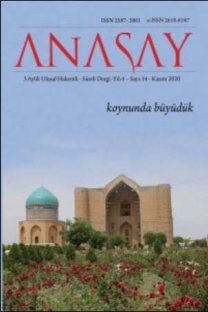EVLİLİK ÖNCESİ EĞİTİM PROGRAMININ GELİŞTİRİLMESİ VE SONUÇLARININ DEĞERLENDİRİLMESİ (ERZİNCAN ÖRNEĞİ)
evlilik, aile, evlilik öncesi eğitm, evlilik eğitimi
DEVELOPING THE PREMARITAL EDUCATION PROGRAM AND EVALUATION OF ITS RESULTS (ERZİNCAN CASE)
Marriage, Family, Premarital Education, Marriage Education.,
___
- KAYNAKÇA Altuntaş, S., & Atli, A. (2015). Eş seçme stratejileri envanteri geliştirilmesi . Mustafa Kemal Üniversitesi Sosyal Bilimler Enstitüsü Dergisi, 12(32), 123-135.
- Bader, E., Microys, G., Sinclair, C., Willett, E., & Conway, B. (1980). Do marriage preparation programs really work?: A Canadian experiment. Journal of Marital and Family Therapy , 6(2), 171-179, doi: 10.1111/j.1752-0606.1980.tb01303.x.
- Bagarozzii, D. A., & Rauen, P. (1981). Premarital counseling: appraisal and status. The American Journal of Family Therapy, 9(3), 13-30, doi:10.1080/01926188108250407.
- Barlow, J. L. (1999). A new model for premarital counseling within the church. Pastoral Psychology, 48(1), 3–9. doi:10.1023/a:1021998511250 .
- Braaten, E. B., & Rosen, L. A. (1998). Development and validation of the marital attitude scale. journal of divorce & remarriage, 29(3-4), 83-91.
- Buckner, L. P., & Salts, C. J. (1985). A premarital assessment program. Family Relations, 34(4), 513-520, doi:10.2307/584012 .
- Darling, C. A. (1988). Family Life Education. M. B. Sussman, & S. K. Steinmetz içinde, Handbook of marriage and the family (s. 815-834). Springer.
- Elkin, M. (1977). Premarital counseling for minors: The Los Angeles experience. The Family Coordinator, 26(4), 429-443, doi.org/10.2307/581767.
- Gongla, P. A., & Edward H. Thompson, J. (1988). Single-parent families. M. B. Sussman, & S. K. Steinmetz içinde, Handbook of Marriage and the Family (s. 397-418). Springer.
- Jones, G. D., & Nelson, E. S. (1996). Expectations of marriage among college students from intact and non-intact homes. Journal of Divorce and Remarriage, 826), 171-189.
- Laner, M. R., & Russel, J. N. (1995). Marital expectations and level of premarital involvement: does marriage education make a difference? Teaching Sociology, (23), 28-34.
- Larsen, A. S., & Olson, D. H. (1989). Predicting marital satisfaction using prepare: a replication study. Journal of Marital and Family Therapy , 15(3), 311-322, doi:10.1111/j.1752-0606.1989.tb00812.x .
- Larson, J. n. (1992). You’re my one and only”: premarital counseling for unrealistic beliefs about mate selection . The American Journal of Family Therapy, 20(3), 242–253. doi:10.1080/01926189208250893 .
- Maybruch, C., Pirutinskyb, S., & Pelcovitz, D. (2014). Religious premarital education and marital quality within the orthodox jewish community. Journal of Couple & Relationship Therapy, , (13)4, 365-381, doi:10.1080/15332691.2014.953655.
- Nickols, S. A., Fournier, D. G., & Nickols, S. Y. (1986). Evaluation of a preparation for marriage workshop. Family Relations, 35(4), 563. doi:10.2307/584518 .
- Özen, A., Engin, S. S., & Uğur, N. S. (2016). Romantik ilişkilerde çatışma çözüm stilleri ölçeği: geçerlik güvenirlik çalışması. Nesne Psikoloji Dergisi (NPD), 4(7), 1-19, doi: 10.7816/nesne-04-07-01.
- Ridley, C. A., & Sladeczek, I. E. (1992). Premarital relationship enhancement: its effects on needs to relate to others. Family Relations, 41(2), 148-153 doi:10.2307/584826.
- Risch, G. S., Riley, L. A., & Lawler, M. G. (2003). Problematic issues in the early years of marriage: content for premarital education. Journal of Psychology and Theology , 31(3), 253-269.
- Sürerbiçer, F. S. (2008). Boşanmış bireylerin deneyimlerine göre evlilik eğitimi gereksinimi. 2008: Ankara Üniversitesi / Eğitim Bilimleri Enstitüsü.
- Sabatelli, R. M. (1988). Exploring relationship satisfaction: a social exchange perspective on the interdependence between theory, research, and practice. Family Relations, Vol. 37, No. 2 (Apr., 1988), pp. 217-222, 37(2), 217-222.
- Sevim, Y. (2018). Evlilik öğretilebilir mi? . Uluslararası Sosyal Araştırmalar Dergisi,, 11(61), 606-610.
- Soysal, F. S., Baş, A. U., & Aysan, F. (2016). Evlilik beklentisi ölçeği: geçerlik ve güvenirlik çalışması. Mersin Üniversitesi Eğitim Fakültesi Dergisi, 12(1), 119-128.
- Soysal, F. S., Baş, A. U., & Aysan, F. (2016). Evlilik tutumu ölçeğinin türkçe’ye uyarlanması: geçerlik ve güvenirlik çalışması. Kastamonu Eğitim Dergisi, 24(4), 1951-1964.
- Stahmann, R. F. (2000). Premarital counselling: a focus for family therapy. The Association for Family Therapy, 22(12), 104-116, doi:10.1111/1467-6427.00140 .
- Yıldız, M. (2017). Evlilik olgunluk ölçeğinin geliştirilmesi. Yaşam Becerileri Psikoloji Dergisi, 1(1), 24-34.
- ISSN: 2587-2001
- Yayın Aralığı: Yılda 4 Sayı
- Başlangıç: 2017
- Yayıncı: İshak KÜÇÜKYILDIZ
YENİÇAĞDA OSMANLI PİYADELERİNİN ASKERİ POTANSİYELİ
HAYATIN HAKKINI GÖZETMEK: GİORGİO AGAMBEN’İN SİYASET FELSEFESİ
KÜRESELLEŞEN DÜNYA’DA DAĞ VE İNSAN ETKİLEŞİMİ: RİZE DAĞLARI ÖRNEĞİ
MÜLKİYELİLERİN “BABA”SI: AYNÎZÂDE HASAN TAHSİN (1876-1962)
KUŞTAN AL HABERİ: YAZIŞMADAN YARIŞA POSTA GÜVERCİNLERİ ÜZERİNE BİR İNCELEME
ANTİK YUNAN’DAN YAŞAYAN SÖZLER’DE KADIN
IRAK İLE KUVEYT ARASINDAKİ SINIR MÜNASEBETLERİ
İSMET ÖZEL ŞİİRİNDE ‘KAHRAMAN BEN’İN GÖRÜNÜMLERİ
AN IRONIC INTERSECTION OF REALITY AND FICTIONALITY: TLÖN, UQBAR, ORBIS TERTIUS
